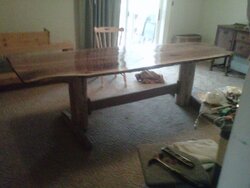I picked up a couple of rough cut pieces of red oak last week from a small mill located at a farm down the road.......am planning to use as mantles over the fireplaces in the family room and the basement. They are 8'X10"X3".....some questions:
I wanted to leave the saw marks but wanted to protect it with some sort of finish....maybe Tung Oil, any other suggestions? These were cut from an 8' log and are still wet, should I let dry before I install (that might be months if I do) or before I apply a finish? They are currently sitting in the garage and my wife is complaining about the smell....I think it smells good but she says it smells like dog poop. Both fireplaces are brick with brick supports built in to support the mantles....how do I attach the wooden matle to the brick?
I wanted to leave the saw marks but wanted to protect it with some sort of finish....maybe Tung Oil, any other suggestions? These were cut from an 8' log and are still wet, should I let dry before I install (that might be months if I do) or before I apply a finish? They are currently sitting in the garage and my wife is complaining about the smell....I think it smells good but she says it smells like dog poop. Both fireplaces are brick with brick supports built in to support the mantles....how do I attach the wooden matle to the brick?



